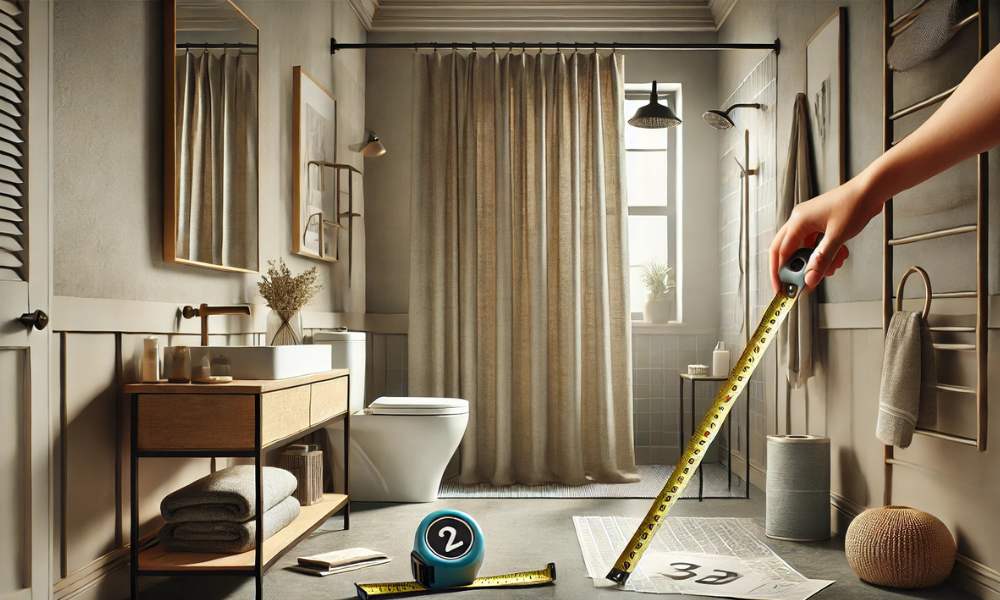Shower curtains are a vital element of bathroom decor and functionality, but many people wonder, how are shower curtains measured? Proper measurement ensures the perfect fit, avoiding water spills and enhancing the bathroom’s style. To measure, you need to know the shower rod’s width and the desired length for the curtain. Standard sizes often fit most tubs, but custom measurements may be required for unique setups. Don’t forget to factor in the curtain’s hem and any decorative designs. Measuring correctly saves time, prevents returns, and helps you choose the ideal curtain for your space. Whether you’re redecorating or replacing, accurate shower curtain measurements make all the difference in achieving a polished, functional bathroom design.
Understanding Shower Curtain Measurements

At its core, measuring a shower curtain boils down to two elements: width and height. These dimensions ensure the curtain fits snugly over your bathing area, shielding the rest of the room from splashes while looking effortlessly elegant. Whether it’s a classic bathtub, a minimalist shower stall, or a vintage clawfoot tub, precise measurements allow the curtains to complement the space seamlessly.
Tools You’ll Need For Precision

Before beginning, ensure you have these essentials:
- Measuring Tape: A retractable one works best for accuracy and convenience.
- Notebook and Pen: Vital for jotting down your numbers before they slip from memory.
- Step Stool: If your curtain rod is mounted high, this ensures safe and easy access.
- A Second Pair of Hands: Sometimes, measuring is smoother with a helper steadying the tape.
With these tools in hand, you’re equipped to tackle the task without frustration.
Common Pitfalls To Avoid
Mistakes are easy to make, but equally easy to avoid when you’re aware of them:
- Ignoring Overlap: A miscalculation here leaves unsightly gaps that invite water to escape.
- Measuring Without the Rod in Place: Curtains depend on rod positioning; skipping this step can throw off your dimensions.
- Misjudging the Drop: A curtains that drags on the floor or stops too high can disrupt both aesthetics and functionality.
- Blindly Trusting “Standard” Sizes: Not every shower fits the mold, so never skip measuring.
Step-By-Step Guide Measuring Like A Pro
- Secure the Rod: Install the curtain rod before taking measurements; its placement is your baseline.
- Measure the Width: Stretch your measuring tape horizontally across the rod’s length.
- Determine the Height: Start from the rod and extend the tape down to where the curtain should end—usually 2 inches above the tub or floor.
- Account for Hardware: If using hooks or grommets, add the necessary inches to your calculations.
Precision in these steps ensures your curtains not only fits but flows gracefully.
Decoding Standard Width Sizes
While customization is always an option, most shower curtains fall into these standard widths:
- Bathtub Curtains: 70 to 72 inches wide, ideal for covering standard tub setups.
- Shower Stall Curtains: Narrower at 36 to 54 inches, suited to compact spaces.
These dimensions work as a guide but should always be verified against your specific setup.
Mastering The Height Measurement

Height plays a crucial role in a curtain’s overall look and practicality. Here’s how to get it right:
- For Bathtubs: Measure from the rod to 1-2 inches above the tub’s edge to prevent dragging.
- For Standalone Showers: Leave a 2-3 inch clearance above the floor for a neat finish.
Consider any embellishments or decorative hems that could alter the final drop.
Getting The Width Right

Width measurements need more than a straight-line approach. After measuring the rod’s length, add 10-12 extra inches. This allowance ensures your wide are shower curtains can pleat naturally, avoiding a stretched or skimpy appearance. The result? Full coverage with an elegant drape.
Key Factors To Consider
Several details can influence your measurements:
- Rod Shape: A curved rod demands more width to account for its outward arc.
- Hardware Choice: Hooks and grommets can subtly shift how the curtain hangs.
- Décor Harmony: Ensure the curtain’s dimensions align with your bathroom’s overall aesthetic.
- Water Containment: Proper measurements prevent leaks, safeguarding your floors.
Customizing For Unique Shower Types

Different showers call for distinct approaches:
- Corner Showers: Measure each side individually and add overlap for a seamless corner.
- Clawfoot Tubs: These often require circular curtains. Measure the circumference of the rod rather than width.
- Sliding Door Showers: If combining a curtain with sliding doors, measure only the open area for partial coverage.
Understanding the “Drop”
The curtain’s drop—the distance from rod to endpoint—is as functional as it is visual. Too short, and the shower curtains measured looks unfinished; too long, and it becomes a tripping hazard. For most setups, a 2-inch clearance above the floor or tub rim offers the ideal balance of practicality and style.
Measurements For Grommet Curtains
For curtains with grommets, precision is key. Measure from the top of the grommet opening to the desired endpoint. Add the rod’s diameter to ensure the curtains hangs correctly, filling any potential gaps with ease.
Measuring For Hooked Curtains
When using hooks, take measurements from the top of the hook to the shower curtains measured endpoint. The hook’s added height should be factored into your calculation to achieve a polished look.
Avoiding Overcrowding With The Right Width
A curtain that’s too wide overwhelms the space, while one that’s too narrow leaves awkward gaps. The solution lies in balance. Choose a width that allows gentle pleating without excessive bunching, maintaining both functionality and aesthetic harmony.
Matching Curtain Sizes To Decor Styles

Shower curtains serve a dual purpose: practicality and design.
- Minimalist Spaces: Opt for sleek, tailored curtains that fit precisely.
- Bohemian or Eclectic Bathrooms: Embrace slightly oversized curtains for a relaxed, layered effect.
By aligning the curtain’s size with your style, you create a cohesive look that enhances the entire room.
Frequently Asked Questions
– Do Shower Curtains Need to Touch the Floor?
No, shower curtains should not touch the floor. Ideally, they should hang about 2 inches above the floor to prevent water from pooling, reduce mildew growth, and keep the curtain clean. This also ensures the curtains drapes well without creating a tripping hazard.
– How Do I Measure Shower Curtain Height and Width?
To measure shower curtain height, start from the curtain rod and measure down to where you want the curtains to end, typically 2 inches above the floor. For the width, measure the width of the shower or tub and add 12 inches for proper draping. Accurate measurements ensure a functional and visually appealing curtain.
Final Thoughts
Knowing how shower curtains are measured ensures the perfect fit for your bathroom. Measure the width of your shower or tub and add 12 inches to account for proper draping. For the height, measure from the curtains rod to the floor, subtracting a few inches to avoid dragging. By understanding these simple steps, you can confidently choose the right size for functionality and style.
